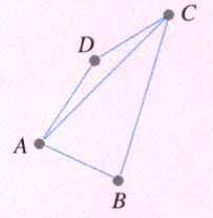For an equilateral prism ∠A+∠i=∠e+∠D
To solve the question regarding the relationship between the angles in an equilateral prism, we need to analyze the terms mentioned and the correct relationship between them.
1. Understand the Terms:
- Angle A: This is the angle of the prism, which is the angle between the two faces of the prism.
- Angle I: This is the angle of incidence, which is the angle at which light enters the prism relative to the normal (perpendicular) to the surface.
- Angle E: This is the angle of emergence, which is the angle at which light exits the prism relative to the normal.
- Angle D: This is the angle of deviation, which is the angle by which the light ray is deviated from its original path after passing through the prism.
2. Identify the Correct Relationship:
- The correct relationship for an equilateral prism is given by the formula:
Angle A+Angle D=Angle I+Angle E
- This means that the sum of the angle of the prism and the angle of deviation is equal to the sum of the angle of incidence and the angle of emergence.
3. Evaluate the Given Statement:
- The statement provided in the question is:
Angle A+Angle I=Angle E+Angle D
- This statement is incorrect based on the established relationship.
4. Conclusion:
- Therefore, the correct relationship is:
Angle A+Angle D=Angle I+Angle E
- The given statement in the question is false.
- Angle A: This is the angle of the prism, which is the angle between the two faces of the prism.
- Angle I: This is the angle of incidence, which is the angle at which light enters the prism relative to the normal (perpendicular) to the surface.
- Angle E: This is the angle of emergence, which is the angle at which light exits the prism relative to the normal.
- Angle D: This is the angle of deviation, which is the angle by which the light ray is deviated from its original path after passing through the prism.
- The correct relationship for an equilateral prism is given by the formula:
Angle A+Angle D=Angle I+Angle E
- This means that the sum of the angle of the prism and the angle of deviation is equal to the sum of the angle of incidence and the angle of emergence.
- The statement provided in the question is:
Angle A+Angle I=Angle E+Angle D
- This statement is incorrect based on the established relationship.
- Therefore, the correct relationship is:
Angle A+Angle D=Angle I+Angle E
- The given statement in the question is false.
Topper's Solved these Questions
- BOOK - ICSECHAPTER - LIGHT ENERGYEXERCISE - EXERCISE-5.4 (Objective Type Questions) C. Write .true.of .false. for the following statements :5videos
LIGHT ENERGY
- BOOK - ICSECHAPTER - LIGHT ENERGYEXERCISE - EXERCISE-5.4 (Objective Type Questions) D. Tick the most appropriate answer.5videos
LIGHT ENERGY
- BOOK - ICSECHAPTER - LIGHT ENERGYEXERCISE - EXERCISE-5.4 (Objective Type Questions) (A. Fill in the blank spaces by choosing the correct words from the list given below :) (List: two, base, dispersion, prism, deviation)5videos
LIGHT ENERGY
- BOOK - ICSECHAPTER - HEAT TRANSFER EXERCISE - Picture Study2videos
HEAT TRANSFER
- BOOK - ICSECHAPTER - MATTER EXERCISE - THEME ASSIGNMENT25videos
MATTER
Similar Questions
For a prism ∠A+∠D=∠i+∠e= _______
View SolutionFind ∠A+∠B+∠C+∠D
 View Solution
View SolutionFind the angle of minimum deviation for an equilateral prism made of a material of refractive index 1.732. What is the angle of incidence for this deviation ?
View SolutionA beam of monochromatic light is incident at i=50∘ on one face of an equilateral prism, the angle of emergence is 40∘, then the angle of minimum deviation is :
View SolutionWrite a relation for the angle of deviation (δ) for a ray of light passing through an equilateral prism in terms of the angle of incidence (i1), angle of emergence (i2) ang angle of prism (A).
View SolutionAngle of minimum deviation is equal to the angle prism A of an equilateral glass prism. The angle incidence at which minimum deviation will be obtained is
View SolutionDraw a neat diagram for the passage of a ray of light through an equilateral glass prism, showing clearly
(a) angle of incidence (b) angle of emergence ( c ) angle of deviation (d) angle of prismView SolutionA ray of light is incident normally on one face of an equilateral prism of refractive index 1.5. The angle of deviation is: (Given sin−1.23=42∘)
View SolutionIf the angle of minimum deviation is of 60∘ for an equilateral prism , then the refractive index of the material of the prism is
View SolutionA ray of light passes through an equilateral glass prism in such a manner that the angle of incidence is equal to the angle of emergence and each of these angles is equal to 3/4 of the angle of the prism. The angle of deviation is
View Solution

